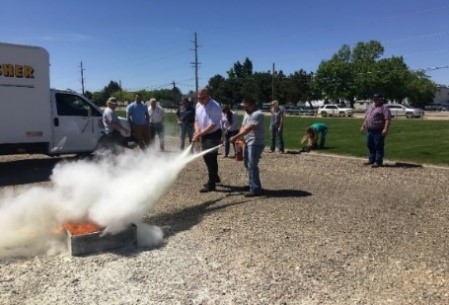
Written by: Lacie Dotterweich | August 12, 2020

Every second week of August, workplaces across the country show their commitment to making sure their workers are kept safe on the job. The Occupational Safety and Health Administration’s annual Safe + Sound Week is a nationwide event that recognizes the successes of workplace health and safety programs across various industries and offers information and ideas on how to protect America's workers.
I think we can all agree - safety is everyone’s responsibility in the animal food manufacturing industry. By implementing successful programs, our industry is proactively identifying and managing workplace hazards before they cause injuries or illnesses.
To highlight the animal food industry’s dedication to safety this week, I interviewed a few American Feed Industry Association members on how they make safety and health a top priority. Read on to find out what has worked best for them.
Brotherson: While our employees are at work, we want them to not only feel safe, but to be safe as well. Everyone has safety programs, but if it is not presented with excitement and enthusiasm, employees will not be engaged and will not retain the information. Whenever possible, we do hands-on training. For example, during our fire safety training, not only do we show a training video and cover our company’s material, but we also have a local fire extinguisher company come on-site and the meeting moves outdoors to a safe zone. We then start contained fires and every employee will put it out using a fire extinguisher, so they feel comfortable handling it.

Another method we use to engage employees is to pick one of the employee’s peers to lead the topic. This not only keeps everyone more engaged with the training, it really helps that day’s teacher retain the information much better and gives them a feeling of ownership when they see someone not following what they taught. For example, during our “LOTO” (Lock Out-Tag Out) training, we had a production member lead the teaching. He did not know a lot about LOTO because it was not something he deals with daily, but he is required to know the procedure. He gathered the information, along with props and videos, and presented them to the facility manager and safety coordinator for approval a few days before the class was held. They gave him a few pointers and filled in some knowledge gaps so he would be prepared. On the day of the class, he showed a couple of short videos and props and held a Q&A session and seemed to be very knowledgeable on the topic. Both methods have worked well for us and the staff seems to be more engaged with safety.
Jones: A safe and healthy workplace not only makes good business sense, but it also improves employee morale. Everyone wants to work in an environment where they feel safe, comfortable and confident. They can then perform their duties to the best of their abilities to meet our customers’ needs and go home safe every day.
Animix teaches safety in all aspects of our employees’ lives, not just at work. We believe that wellness and safety go hand-in-hand, so our education and awareness strategies have combined these. For example, we educate employees on healthy diets and lifestyles, ways to cope with stress, COVID-19 precautions, as well as stretching, forklift certifications, LOTO and OSHA safe work practices.
Our safety committee does routine walk-arounds, maintains a safety resolution checklist, posts educational materials on safety bulletin boards and invites a guest employee to monthly safety meetings, so they get routine feedback and suggestions from our employees. Our monthly employee newsletter has safety tips as well as a new COVID-19 section. Their constant interaction keeps us all thinking about safety every day.
We strongly believe in rewarding employees for a job well done. Animix presents awards to employees for following safety rules (e.g., wearing seat belts, using the horn, closing gates, buddy policy, etc.) and having no lost time and accidents.
We believe it is our responsibility to run Animix in a safe manner, as well as encourage our employees to live a safe and healthy life. Our Animix family is worth the investment!
Garczynski: Our last lost time incident was over six years ago – July 14, 2014 – which was about 606,000 work hours and 4,150,000 feed tons ago (as of the end of July). For Koch Mill employees and drivers delivering feed, safety is the most critical thing we perform – in front of every function we accomplish working 24 hours and 5 workday weeks.

We conduct a weekly housekeeping/maintenance condition check each week. Any immediate maintenance needs are notated in each observation area.
We hold prescheduled safety meetings every third Wednesday of the month where we discuss any near-miss incidents and any first aid given during the current month. We always discuss our ongoing safety accomplishments toward “no lost time” and how many current hours we’ve been safe. These meetings include communication on quality control, staffing questions, upcoming tours and completed action on previous inspections. All Koch Mississippi managers also attend a monthly safety meeting composed from the same function areas, just at the next management level.
All safety milestones are celebrated with T-shirts or jackets indicating the accomplishment. Since safety is a large portion of the AFIA Feed Facility of the Year program, we made special recognition clothing for our 2018 integrator category and 2019 Feed Facility of the Year awards. Also, I should note that we get all of our new employees through the folks that already work here. They enjoy working in such a clean and safe environment, so people recommend us to their family members and friends.
Comments See our policy on comments